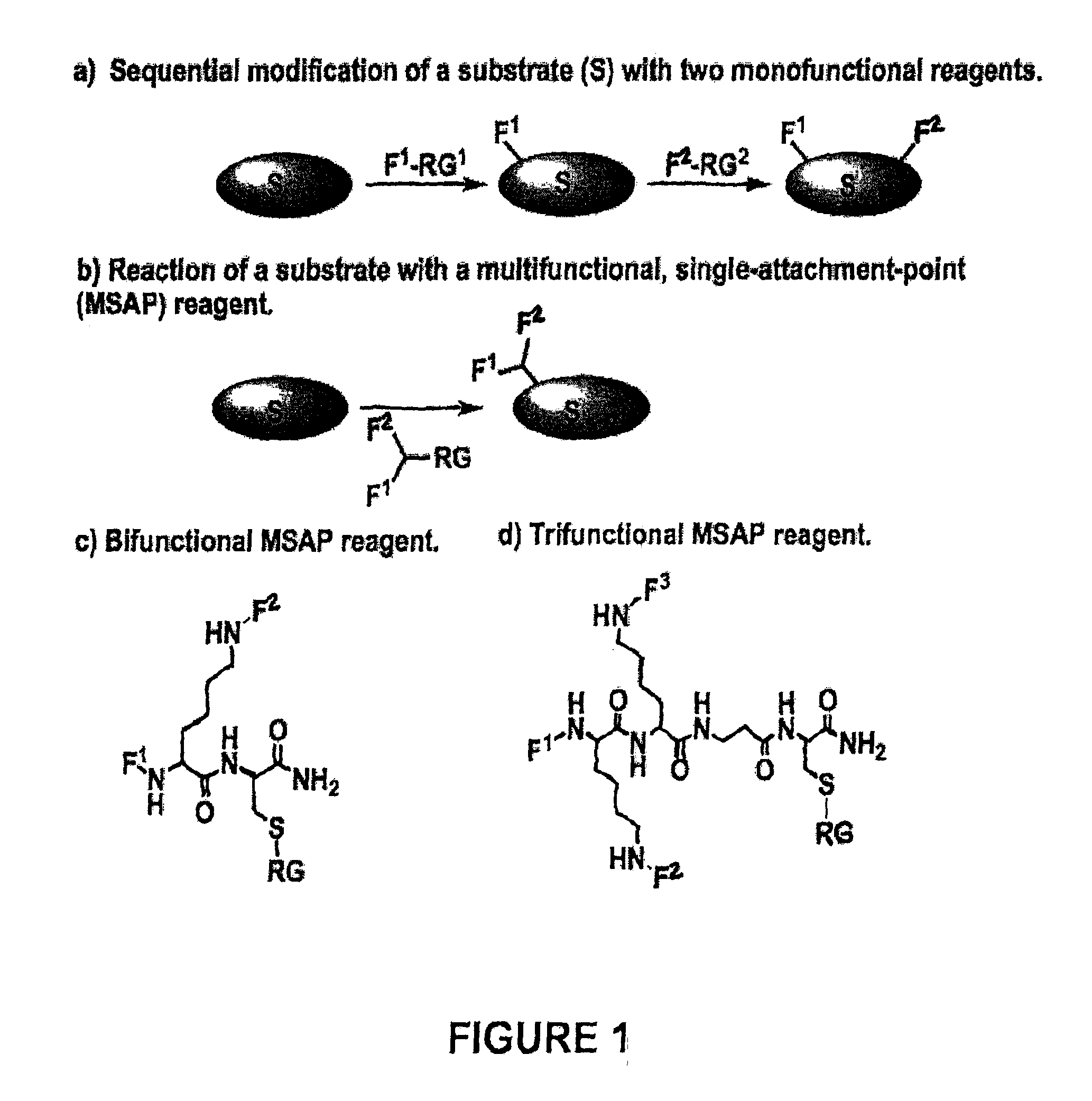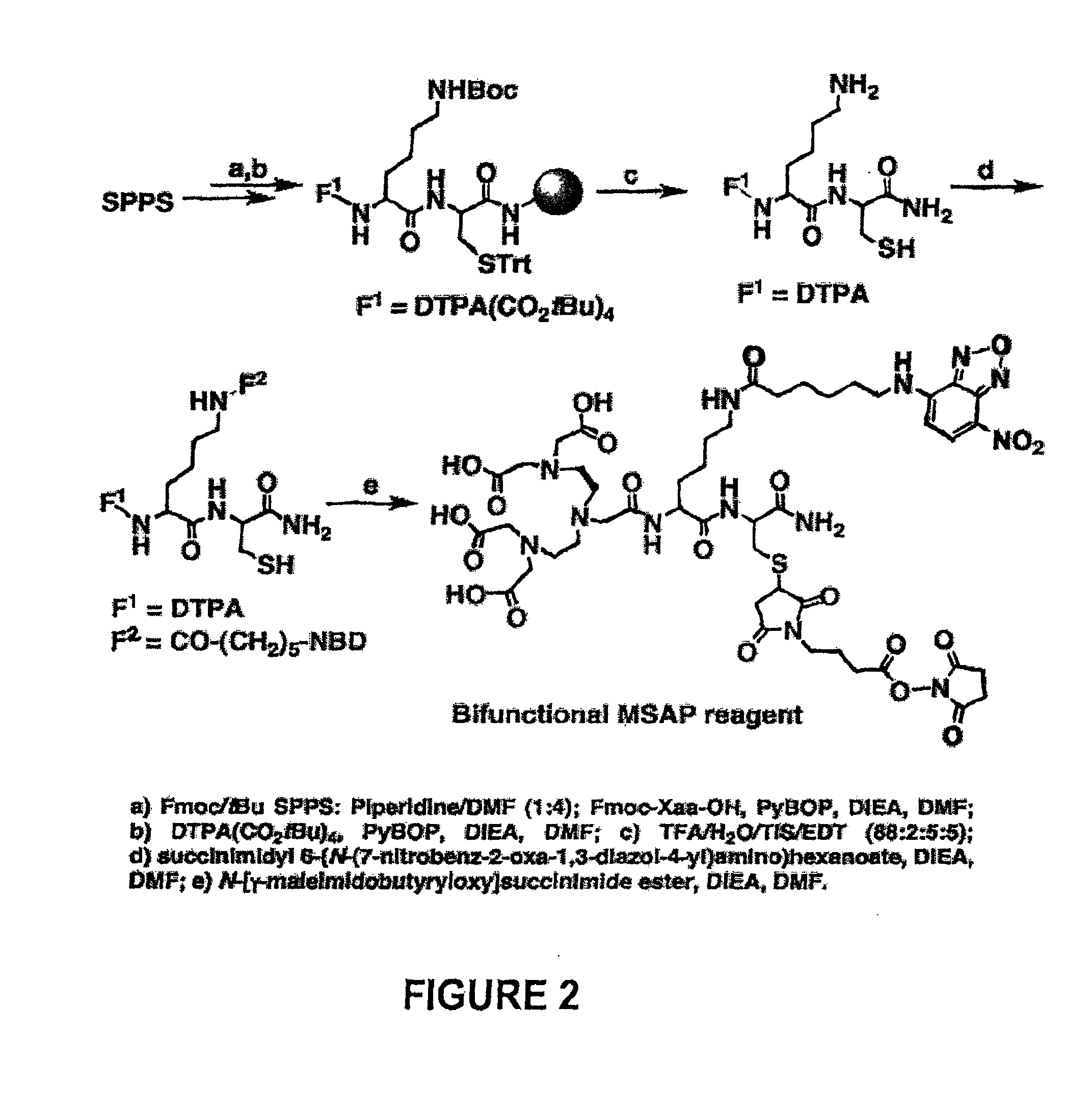Methods and Reagents for Preparing Multifunctional Probes
a multi-functional, probe technology, applied in the direction of instruments, peptide/protein ingredients, enzyme stabilisation, etc., can solve the problem of non-stoichiometric functional group attachment and escalate, and achieve the effect of full bioactivity and efficient generation
- Summary
- Abstract
- Description
- Claims
- Application Information
AI Technical Summary
Benefits of technology
Problems solved by technology
Method used
Image
Examples
examples
Materials and Methods
[0053]Protected L amino acids and PyBOP were obtained from Novabiochem (EMD Biosciences). Other sources were: DTPA(CO2tBu)4 (Macrocyclics), N-[g-maleimidobutyryloxy] succinimide ester (Pierce), succinimidyl 6-(N-(7-nitrobenz-2-oxa-1,3-diazol-4-yl)amino)hexanoate (Invitrogen), and mPEG-NHS ester (5 kDa) (Nanocs Inc).
[0054]RP-HPLC (Varian ProStar detector and delivery modules) employed an eluant A (0.1% TFA / water) and eluant B (0.1% TFA in 9.9% water in acetonitrile). An analytical method (Microsorb 100 Å 5 μm C18 particles, 250×4.6 mm2 column and Metaguard 100 Å 5 μm C18 particles 10×4.6 mm2) employed 1 mL·min−1 with a linear gradient for 30 minutes. A semi-preparative method (Vydac 300 Å 10 μm C18 particles, 250×22 mm2) employed 20 mL·min−1 with a linear gradient for 30 minutes. MS-ESI was done a Micromass (Waters) and MALDI-TOF analyses at the Tufts University Core Facility.
Bifunctional MSAP Synthesis Example 1
DTPA-NBD-NHS ester reagent (F1=DTPA, F2=NBD, RG=NHS...
example 4
Synthesis of Trifunctional MSAP-gold Nanoparticle Probe and its Stabilization
[0068]DTPA-Lys(FITC)-Lys(mPEG)-βAla-Cys(H)—NH2 (100 μL, 258 μM) in citric acid (0.1 M pH 5.7) was added to 1000 μL gold colloids (Sigma Aldrich, 66 nM, 78.5 nm2 / NP, 5 nm nanoparticles) for 2 hours at room temperature and nanoparticles purified by Sephadex G100.
[0069]To obtain the number of MSAPs per nanoparticle, UV / Vis spectra were obtained. The spectra of MSAP-AuNP was treated as the algebraic sum of fluorescein and NP spectra and deconvoluted mathematically to determine the concentrations of MSAP and AuNP. The number of gold atoms per NP was determined from gold concentration and nanoparticle volume.
[0070]For stabilization of the nanoparticle with the MSAP, number weight average diameters were obtained by light scattering using a Nano-2S Zetasizer (Malvern Instruments).
example 5
A Divergent Strategy to Synthesize MSAP Reagents for Protein Conjugation Background for Example 5
[0071]The desire for multifunctional nanoparticles, imaging agents and drug delivery systems is a common theme in diverse areas of biology and medicine. Nanoparticles, some polymers, and antibodies feature many reactive groups per mole, and multifunctional probes can be obtained by independently conjugating several monofunctional molecules (e.g. FITC, DTPA anhydride, NHS esters of PEG, etc.). This strategy has been employed (see, for example, Gao et al., (2004) In vivo cancer targeting and imaging with semiconductor quantum dots. Nat Biotechnol 22, 969-76; Kircher, Weissleder, and Josephson, (2004) A dual fluorochrome probe for imaging proteases. Bioconjug Chem 15, 242-8; and Medarova et al., (2007) In vivo imaging of siRNA delivery and silencing in tumors. Nat Med 13, 372-7). However, the use of independent reagents yields multifunctional probes that lack a stoichiometric relationship b...
PUM
| Property | Measurement | Unit |
|---|---|---|
| Ratio | aaaaa | aaaaa |
| Magnetism | aaaaa | aaaaa |
| Paramagnetism | aaaaa | aaaaa |
Abstract
Description
Claims
Application Information
 Login to View More
Login to View More - R&D
- Intellectual Property
- Life Sciences
- Materials
- Tech Scout
- Unparalleled Data Quality
- Higher Quality Content
- 60% Fewer Hallucinations
Browse by: Latest US Patents, China's latest patents, Technical Efficacy Thesaurus, Application Domain, Technology Topic, Popular Technical Reports.
© 2025 PatSnap. All rights reserved.Legal|Privacy policy|Modern Slavery Act Transparency Statement|Sitemap|About US| Contact US: help@patsnap.com



